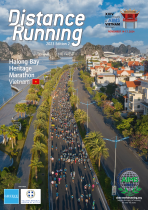Opinion
08 October 2019, 7am
Useful, or just looks the part?
People run distance races in vastly different conditions. They range from hot and humid to cold and dry and include everything else in between.
Race organisers try to provide runners with things like post-race snacks and space blankets to enhance their race experience but also to reduce the risks of competing in these conditions. Over the years it has become standard practice for runners to receive a reflective blanket at the finish line to reduce cooling in cold temperatures and overheating in hot or sunny weather. But do these blankets really help?
When making decisions about what to do to keep runners safe, medical directors look to best practice as shown through science and in published literature. But there is almost nothing published about whether giving out reflective blankets to marathon finishers is in any way helpful. Current literature overwhelmingly documents the use of reflective blankets in hospitals.
‘Space’ blankets were first used in space because of their insulating properties – hence their name. Claims that ‘space blankets’ reflect up to 90% of a person’s body heat and can be flipped to deflect heat from external heat sources suggest they would also be a logical choice to help the endurance runner.
As endurance athletes compete their metabolic system produces kinetic energy to propel themselves through muscular contraction. But the process is very inefficient: 75% of this kinetic energy is lost as heat. During a marathon dissipating heat is essential to maintaining an appropriate core temperature in the athlete.
There are two ways an athlete can lose heat: wet heat loss is from the evaporation of sweat and is the main way that the body dissipates heat during metabolism, accounting for up to 50% of heat dissipation; ‘Dry cooling’ is effected through convection and radiation.
It is easy to understand why reflective blankets are used in controlled operative environments where the patient is stationary and can be wrapped. A race environment is entirely different. Literature yields no data suggesting that reflective blankets can help to warm you. Based on human physiology and science one would think that the warming effect would be minimal for several obvious reasons:
1. Runners are still sweating when they cross the finish line which maintains a significant evaporative cooling effect.
2. Runners are typically still moving while wearing the reflective blankets which increases the convective cooling effect.
3. Runners do not fully wrap themselves but more often wear the blanket like a superhero cape which diminishes its reflective properties.
4. Runners may not wear the blanket with the reflective side inward (lessening the reflective warming effects).
In hot, humid environments a reflective blanket could increase core body temperature (CBT). A 2015 study suggests this is not the case. It compared the effects of CBT cooling rates in four post-exercise conditions: no blanket, blanket, recovery walking with blanket, and recovery walking with no blanket. The researchers attempted to bring the core temperatures of the participants up to a temperature that is commonly seen in endurance running and then tracked cooling rates. They found ‘no significant differences in CBT cooling rates that would have been caused specifically by the reflective blankets.’ There was also no evidence that the use of reflective blankets prolonged the cooling periods of runners.
There is no current research to support the use of reflective blankets as warming aids in a race setting. Speculation seems to have guided decision making rather than letting science be a guide. The distribution of reflective blankets could even be counter-productive through giving runners a false sense of security, leading them to take longer to leave the race finish chutes. This could lead to increased hypothermic effects through prolonged evaporative and conductive cooling effects.
It’s time to re-think.
Reprinted and revised from the IIRM e-journal Endurance and Sports Medicine, Fall/Winter 2018, Vol. 2, No. 3. https://racemedicine.org






